Surface Acoustic Wave Resonators for Wireless Sensor Network Applications in the 433.92 MHz ISM Band
Abstract
1. Introduction
2. Materials and Methods
2.1. Fabrication Process
2.2. Electrical Characterization
3. Results
3.1. Design and Simulation
3.2. Saw Resonators on ST-Cut Quartz
3.3. Evaluation of Process Variations
3.4. Saw Resonator Performance
3.5. Variation Across a Single Wafer
4. Discussion
Author Contributions
Funding
Acknowledgments
Conflicts of Interest
Data Availability
References
- Gombe, B.; Merou, G.; Breschi, K.; Guyennet, H.; Friedt, J.M.; Felea, V.; Medjaher, K. A SAW wireless sensor network platform for industrial predictive maintenance. J. Intell. Manuf. 2019, 30, 1617–1628. [Google Scholar] [CrossRef]
- Zhang, X.; Wang, F. Key Technologies of Passive Wireless Sensor Networks Based on Surface Acoustic Wave Resonators. In Proceedings of the 2008 IEEE International Conference on Networking, Sensing and Control, Sanya, China, 6–8 April 2008. [Google Scholar]
- Jeoti, V.; Nawaz, F. Wireless RFID/sensor network using SAW (WiRSeNS): A feasibility study. In Proceedings of the 2015 3rd International Conference on Signal Processing, Communication and Networking (ICSCN), Chennai, India, 26–28 March 2015. [Google Scholar]
- Goavec-Merou, G.; Breshi, K.; Martin, G.; Ballandras, S.; Bernard, J.; Droit, C.; Friedt, J.M. Multipurpose Use of Radiofrequency Sources for Probing Passive Wireless Sensors and Routing Digital Messages in a Wireless Sensor Network. In Proceedings of the 2012 IEEE International Conference on Green Computing and Communications, Besancon, France, 20–23 November 2012; pp. 675–680. [Google Scholar]
- Ruppel, C.C.W. Acoustic Wave Filter Technology-A Review. IEEE Trans. Ultrason. Ferroelectr. Freq. Control 2017, 64, 1390–1400. [Google Scholar] [CrossRef] [PubMed]
- Kalinin, V. Wireless physical SAW sensors for automotive applications. In Proceedings of the 2011 IEEE International Ultrasonics Symposium, Orlando, FL, USA, 18–21 October 2011; pp. 212–221. [Google Scholar]
- Kalinin, V.; Bown, G.; Leigh, A. P1K-3 Contactless Torque and Temperature Sensor Based on SAW Resonators. In Proceedings of the 2006 IEEE Ultrasonics Symposium, Vancouver, BC, Canada, 2–6 October 2006; pp. 1490–1493. [Google Scholar]
- Plessky, V.P.; Reindl, L.M. Review on SAW RFID tags. IEEE Trans. Ultrason. Ferroelectr. Freq. Control 2010, 57, 654–668. [Google Scholar] [CrossRef] [PubMed]
- Buff, W.; Plath, F.; Schmeckebier, O.; Rusko, M.; Vandahl, T.; Luck, H.; Moller, F.; Malocha, D.C. Remote sensor system using passive SAW sensors. In Proceedings of the 1994 IEEE Ultrasonics Symposium, Cannes, France, 31 October–3 November 1994; Volume 1, pp. 585–588. [Google Scholar]
- Reindl, L.; Scholl, G.; Ostertag, T.; Ruppel, C.C.W.; Bulst, W.; Seifert, F. SAW devices as wireless passive sensors. In Proceedings of the 1996 IEEE Ultrasonics Symposium, San Antonio, TX, USA, 3–6 November 1996; Volume 1, pp. 363–367. [Google Scholar]
- Delsing, P.; Cleland, A.; Schuetz, M.; Knörzer, J.; Giedke, G.; Cirac, J.; Srinivasan, K.; Wu, M.; Balram, K.; Baüerle, C.; et al. The 2019 surface acoustic waves roadmap. J. Phys. Appl. Phys. 2019, 52, 353001. [Google Scholar] [CrossRef]
- Nurashikin Nordin, A.; Zaghloul, M. Design and implementation of a 1 GHz CMOS resonator utilizing surface acoustic wave. In Proceedings of the 2006 IEEE International Symposium on Circuits and Systems, Island of Kos, Greece, 21–24 May 2006. [Google Scholar]
- Nordin, A.N.; Zaghloul, M.E. Modeling and Fabrication of CMOS Surface Acoustic Wave Resonators. IEEE Trans. Microw. Theory Tech. 2007, 55, 992–1001. [Google Scholar] [CrossRef]
- Zhgoon, S.A.; Shvetsov, A.S.; Sakharov, S.A.; Elmazria, O. High-Temperature SAW Resonator Sensors: Electrode Design Specifics. IEEE Trans. Ultrason. Ferroelectr. Freq. Control 2018, 65, 657–664. [Google Scholar] [CrossRef] [PubMed]
- Mamishev, A.V.; Sundara-Rajan, K.; Yang, F.; Du, Y.; Zahn, M. Interdigital sensors and transducers. Proc. IEEE 2004, 92, 808–845. [Google Scholar] [CrossRef]
- Lurz, F.; Ostertag, T.; Scheiner, B.; Weigel, R.; Koelpin, A. Reader architectures for wireless surface acoustic wave sensors. Sensors 2018, 18, 1734. [Google Scholar] [CrossRef] [PubMed]
- Varshney, P.; Panwar, B.S.; Rathore, P.; Ballandras, S.; Francois, B.; Martin, G.; Friedt, J.; Rétornaz, T. Theoretical and experimental analysis of high Q SAW resonator transient response in a wireless sensor interrogation application. In Proceedings of the 2012 IEEE International Frequency Control Symposium Proceedings, Baltimore, MD, USA, 21–24 May 2012; pp. 1–6. [Google Scholar]
- Forsén, E.; Nilsson, D.; Daniau, W.; François, B.; Ballandras, S. Fabrication of SAW resonators on Quartz and Langasite using Nano-Imprint Lithography. In Proceedings of the 2010 IEEE International Ultrasonics Symposium, San Diego, CA, USA, 11–14 October 2010; pp. 2091–2094. [Google Scholar]
- Malocha, D.C.; Humphries, J.R.; Weeks, A.R.; Figueroa, J. SAW passive multi-sensor system: Status and future opportunities. In Proceedings of the 2016 IEEE International Frequency Control Symposium (IFCS), New Orleans, LA, USA, 9–12 May 2016; pp. 1–5. [Google Scholar]
- Canabal, A.; Davulis, P.M.; Pollard, T.; da Cunha, M.P. Multi-sensor wireless interrogation of SAW resonators at high temperatures. In Proceedings of the 2010 IEEE International Ultrasonics Symposium, San Diego, CA, USA, 11–14 October 2010; pp. 265–268. [Google Scholar]
- Sveshnikov, B.V.; Shitvov, A.P. Multitransducer SAW Device Architecture for Passive Wireless Sensor Tags. IEEE Trans. Ultrason. Ferroelectr. Freq. Control 2018, 65, 2176–2183. [Google Scholar] [CrossRef] [PubMed]
- Pereira da Cunha, M.; Maskay, A.; Lad, R.J.; Coyle, T.; Harkay, G. Langasite 2.45 GHz ISM band SAW resonator for harsh environment wireless applications. In Proceedings of the 2016 IEEE International Ultrasonics Symposium (IUS), Tours, France, 18–21 September 2016; pp. 1–4. [Google Scholar]
- Bruckner, G.; Bardong, J. Wireless readout of multiple SAW temperature sensors. Sensors 2019, 19, 3077. [Google Scholar] [CrossRef]
- Morsy, A.M.; Shalaby, H.M.H.; Tilmans, H.A.C. Design Considerations for High Performance One-Port Saw Resonators on Quartz. In Proceedings of the 2008 IEEE International Conference on Semiconductor Electronics, Johor Bahru, Malaysia, 25–27 November 2008. [Google Scholar]
- Tanski, W. Surface Acoustic Wave Resonators on Quartz. IEEE Trans. Sonics Ultrason. 1979, 26, 93–104. [Google Scholar] [CrossRef]
- Ballantine, D.; White, R.; Martin, S.; Ricco, A.; Zellers, E.; Frye, G.; Wohltjen, H.; Levy, M.; Stern, R. Acoustic Wave Sensors: Theory, Design and Physico-Chemical Applications; Academic Press: Cambridge, MA, USA, 1996. [Google Scholar]
- Auld, B. Acoustic Fields and Waves in Solids; Wiley-Interscience Publication: Hoboken, NJ, USA, 1973; Volume 2, Chapter 12. [Google Scholar]
- Toomey, E.; Colangelo, M.; Berggren, K.K. Investigation of ma-N 2400 series photoresist as an electron-beam resist for superconducting nanoscale devices. J. Vac. Sci. Technol. 2019, 37, 051207. [Google Scholar] [CrossRef]
- Malocha, D.C. Evolution of the SAW transducer for communication systems. In Proceedings of the IEEE Ultrasonics Symposium, Montreal, QC, Canada, 23–27 August 2004; Volume 1, pp. 302–310. [Google Scholar]
- McCormack, B.; Geraghty, D.; O’Mahony, M. Modeling of surface acoustic wave strain sensors using coupling-of-modes analysis. IEEE Trans. Ultrason. Ferroelectr. Freq. Control 2011, 58, 2461–2468. [Google Scholar] [CrossRef] [PubMed]
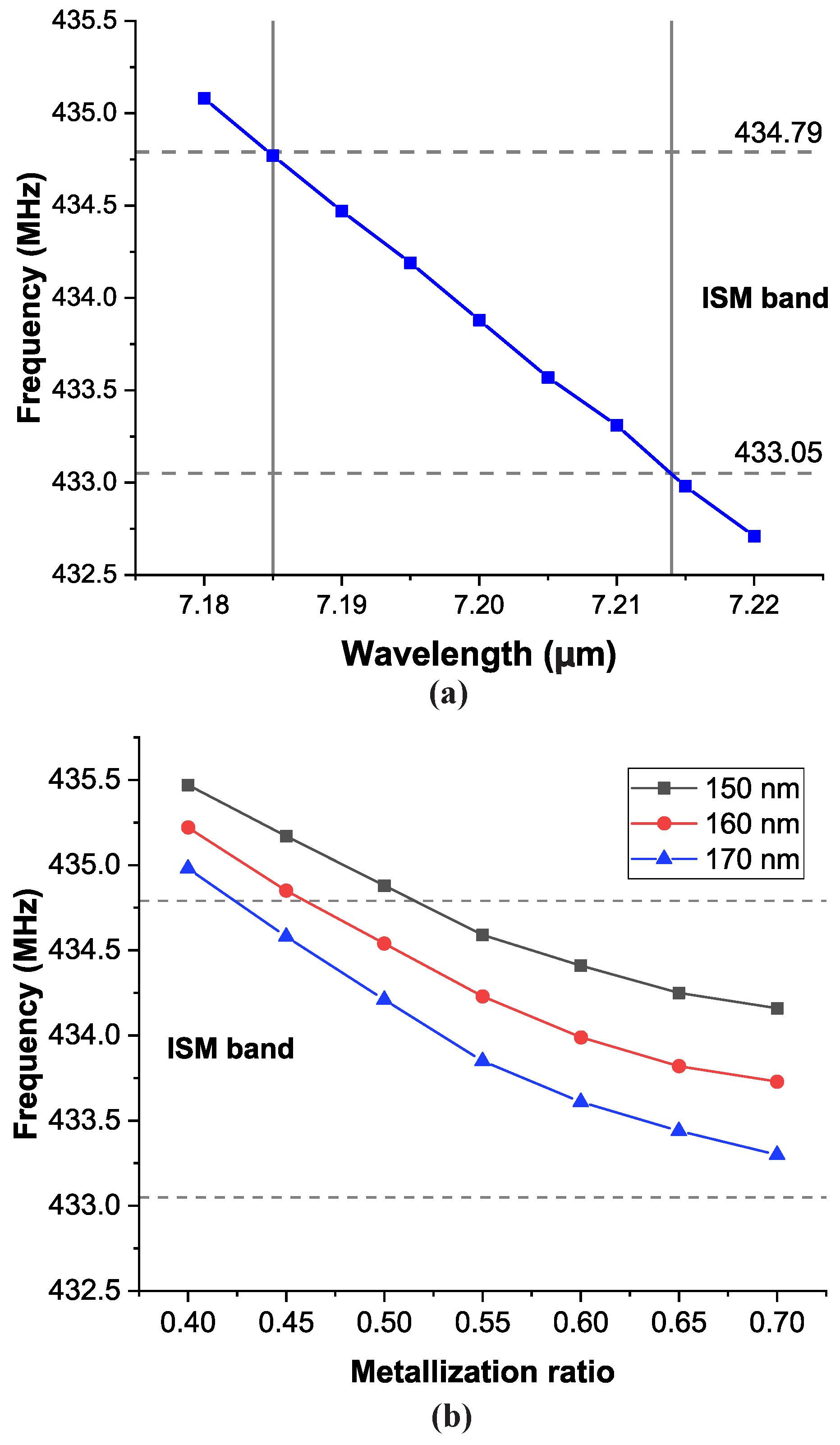
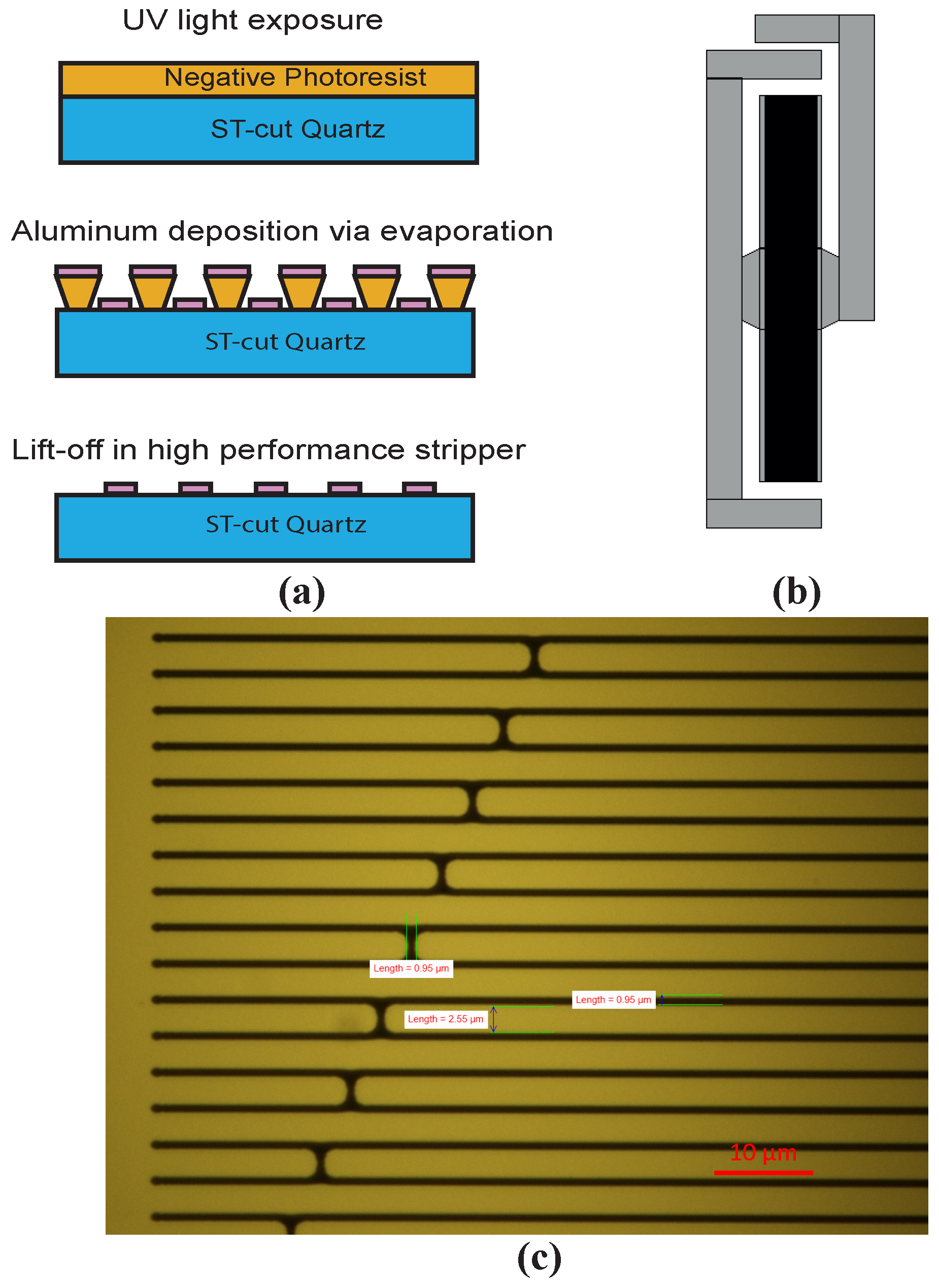
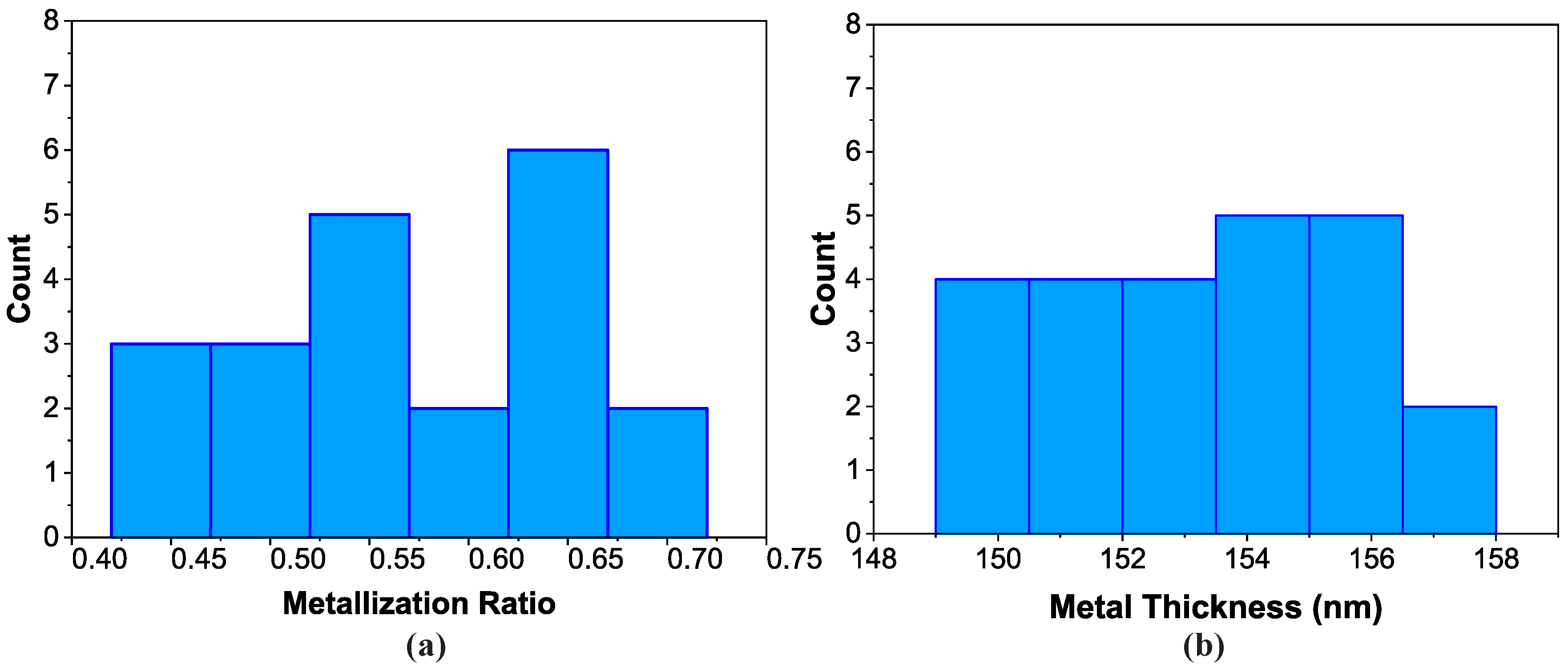
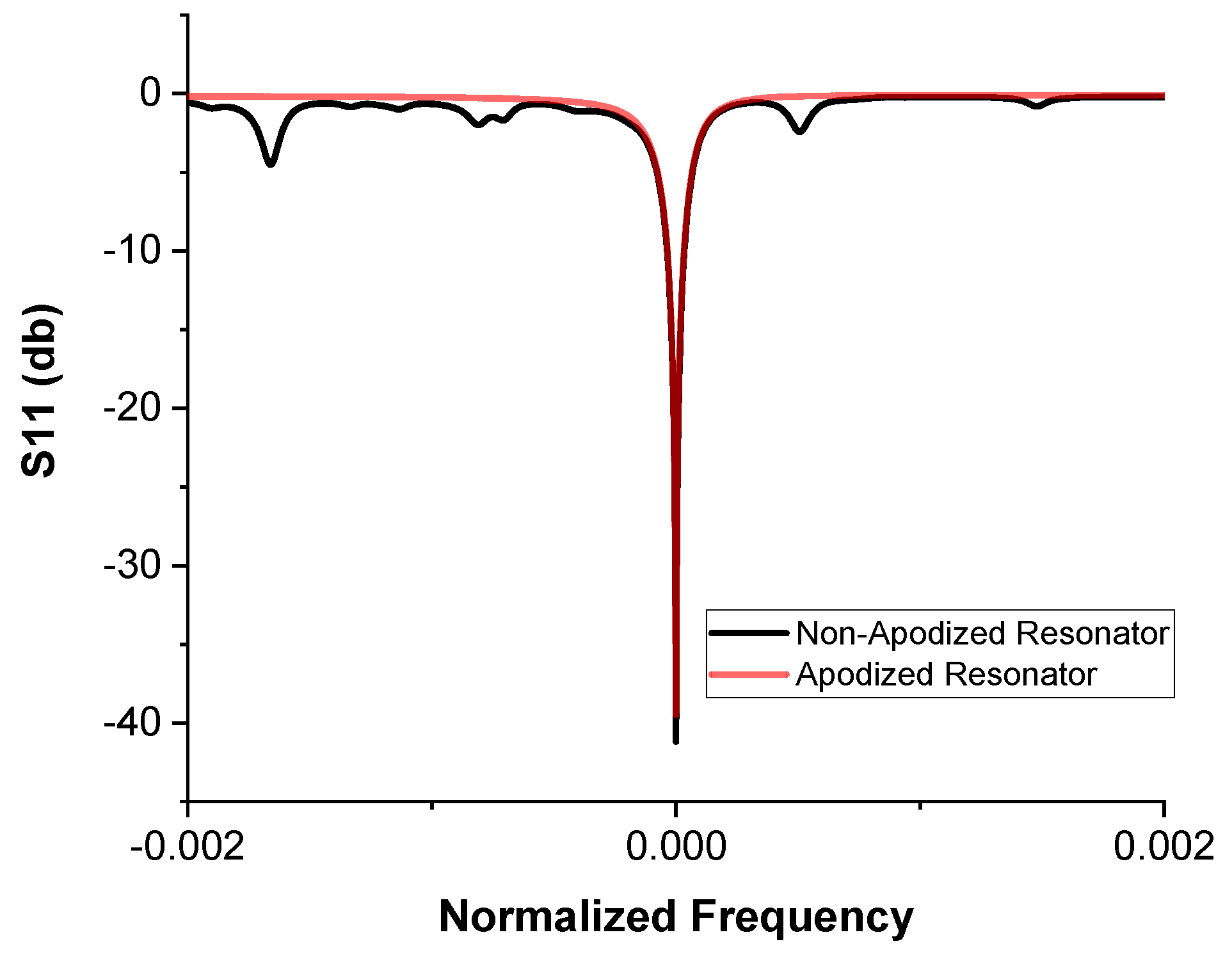
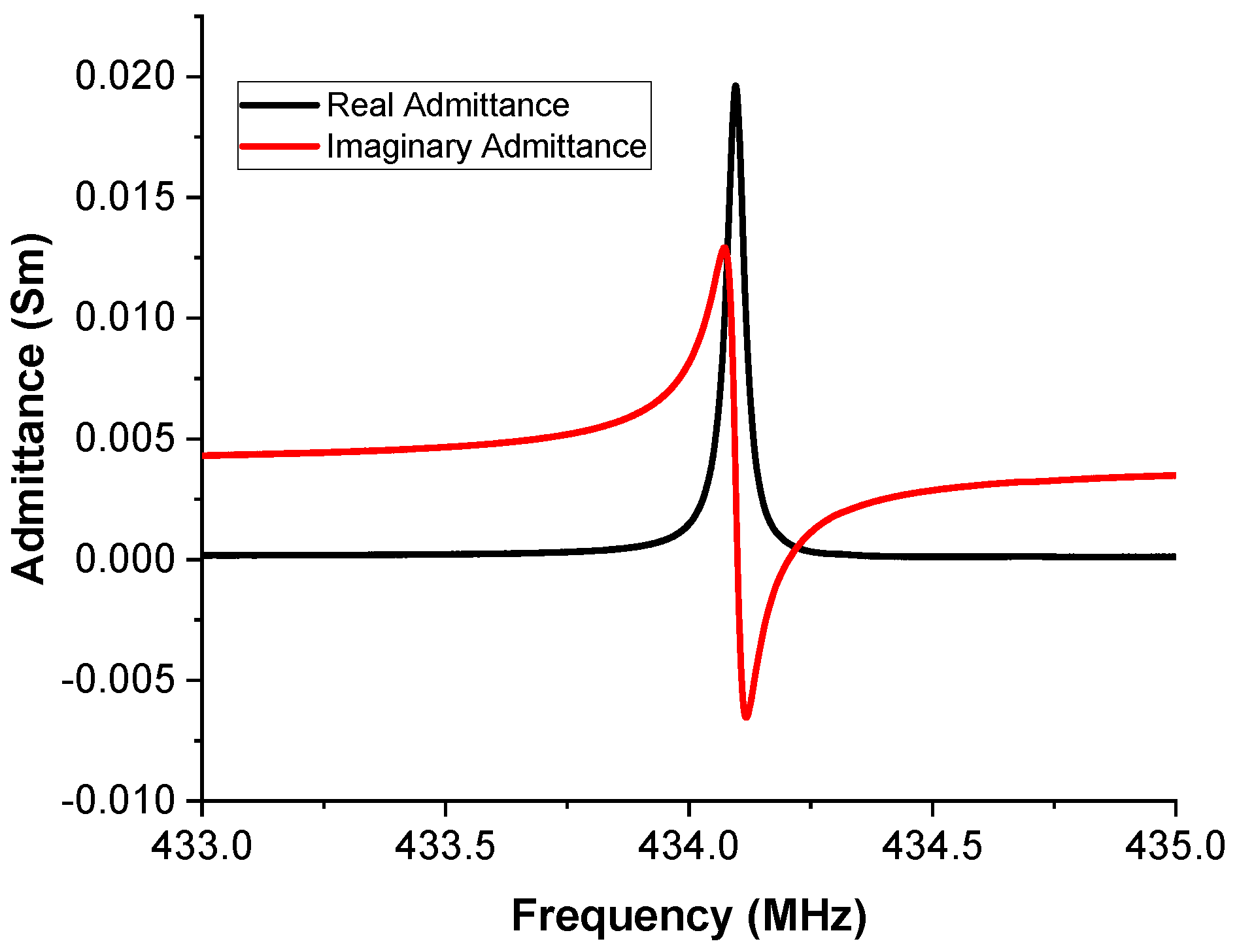

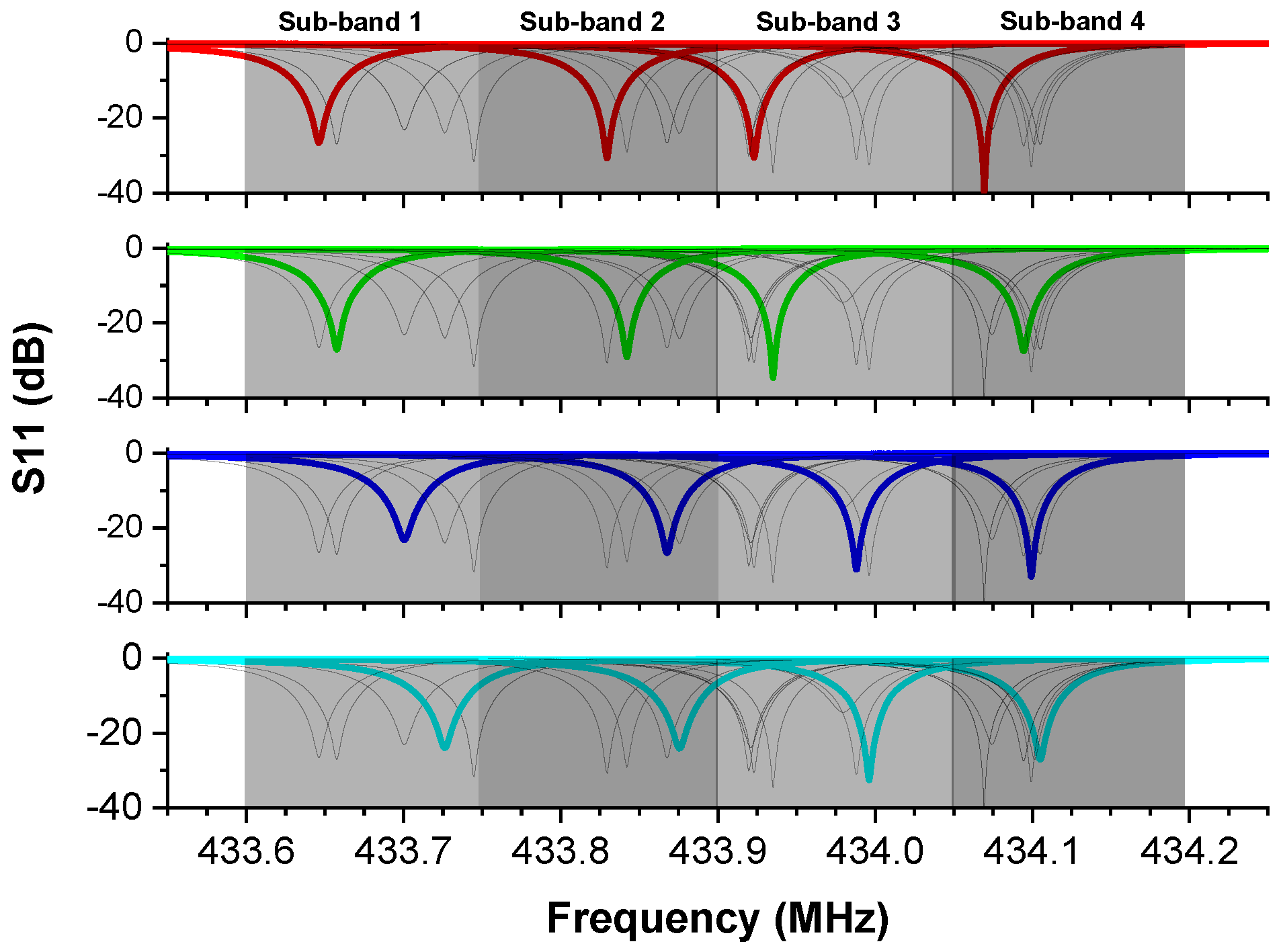
© 2020 by the authors. Licensee MDPI, Basel, Switzerland. This article is an open access article distributed under the terms and conditions of the Creative Commons Attribution (CC BY) license (http://creativecommons.org/licenses/by/4.0/).
Share and Cite
Moutoulas, E.; Hamidullah, M.; Prodromakis, T. Surface Acoustic Wave Resonators for Wireless Sensor Network Applications in the 433.92 MHz ISM Band. Sensors 2020, 20, 4294. https://doi.org/10.3390/s20154294
Moutoulas E, Hamidullah M, Prodromakis T. Surface Acoustic Wave Resonators for Wireless Sensor Network Applications in the 433.92 MHz ISM Band. Sensors. 2020; 20(15):4294. https://doi.org/10.3390/s20154294
Chicago/Turabian StyleMoutoulas, Evangelos, Muhammad Hamidullah, and Themis Prodromakis. 2020. "Surface Acoustic Wave Resonators for Wireless Sensor Network Applications in the 433.92 MHz ISM Band" Sensors 20, no. 15: 4294. https://doi.org/10.3390/s20154294
APA StyleMoutoulas, E., Hamidullah, M., & Prodromakis, T. (2020). Surface Acoustic Wave Resonators for Wireless Sensor Network Applications in the 433.92 MHz ISM Band. Sensors, 20(15), 4294. https://doi.org/10.3390/s20154294





